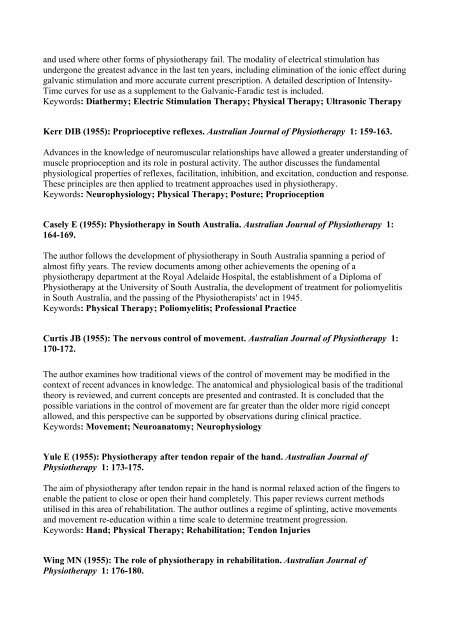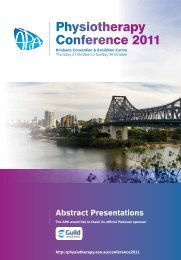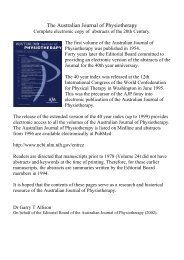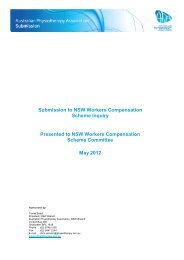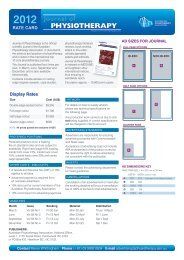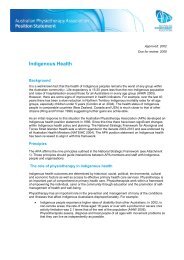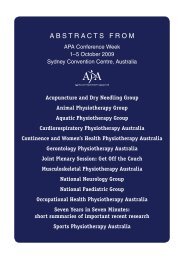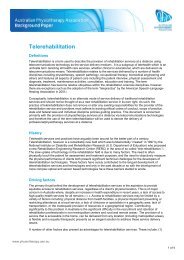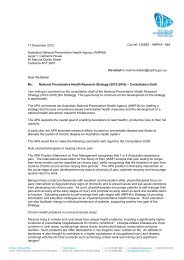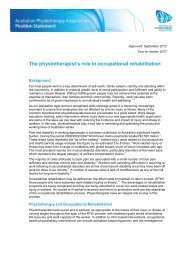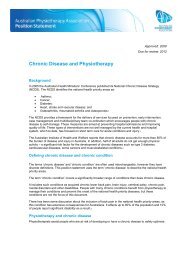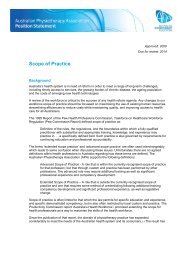The Australian Journal of Physiotherapy
The Australian Journal of Physiotherapy
The Australian Journal of Physiotherapy
Create successful ePaper yourself
Turn your PDF publications into a flip-book with our unique Google optimized e-Paper software.
and used where other forms <strong>of</strong> physiotherapy fail. <strong>The</strong> modality <strong>of</strong> electrical stimulation has<br />
undergone the greatest advance in the last ten years, including elimination <strong>of</strong> the ionic effect during<br />
galvanic stimulation and more accurate current prescription. A detailed description <strong>of</strong> Intensity-<br />
Time curves for use as a supplement to the Galvanic-Faradic test is included.<br />
Keywords: Diathermy; Electric Stimulation <strong>The</strong>rapy; Physical <strong>The</strong>rapy; Ultrasonic <strong>The</strong>rapy<br />
Kerr DIB (1955): Proprioceptive reflexes. <strong>Australian</strong> <strong>Journal</strong> <strong>of</strong> <strong>Physiotherapy</strong> 1: 159-163.<br />
Advances in the knowledge <strong>of</strong> neuromuscular relationships have allowed a greater understanding <strong>of</strong><br />
muscle proprioception and its role in postural activity. <strong>The</strong> author discusses the fundamental<br />
physiological properties <strong>of</strong> reflexes, facilitation, inhibition, and excitation, conduction and response.<br />
<strong>The</strong>se principles are then applied to treatment approaches used in physiotherapy.<br />
Keywords: Neurophysiology; Physical <strong>The</strong>rapy; Posture; Proprioception<br />
Casely E (1955): <strong>Physiotherapy</strong> in South Australia. <strong>Australian</strong> <strong>Journal</strong> <strong>of</strong> <strong>Physiotherapy</strong> 1:<br />
164-169.<br />
<strong>The</strong> author follows the development <strong>of</strong> physiotherapy in South Australia spanning a period <strong>of</strong><br />
almost fifty years. <strong>The</strong> review documents among other achievements the opening <strong>of</strong> a<br />
physiotherapy department at the Royal Adelaide Hospital, the establishment <strong>of</strong> a Diploma <strong>of</strong><br />
<strong>Physiotherapy</strong> at the University <strong>of</strong> South Australia, the development <strong>of</strong> treatment for poliomyelitis<br />
in South Australia, and the passing <strong>of</strong> the Physiotherapists' act in 1945.<br />
Keywords: Physical <strong>The</strong>rapy; Poliomyelitis; Pr<strong>of</strong>essional Practice<br />
Curtis JB (1955): <strong>The</strong> nervous control <strong>of</strong> movement. <strong>Australian</strong> <strong>Journal</strong> <strong>of</strong> <strong>Physiotherapy</strong> 1:<br />
170-172.<br />
<strong>The</strong> author examines how traditional views <strong>of</strong> the control <strong>of</strong> movement may be modified in the<br />
context <strong>of</strong> recent advances in knowledge. <strong>The</strong> anatomical and physiological basis <strong>of</strong> the traditional<br />
theory is reviewed, and current concepts are presented and contrasted. It is concluded that the<br />
possible variations in the control <strong>of</strong> movement are far greater than the older more rigid concept<br />
allowed, and this perspective can be supported by observations during clinical practice.<br />
Keywords: Movement; Neuroanatomy; Neurophysiology<br />
Yule E (1955): <strong>Physiotherapy</strong> after tendon repair <strong>of</strong> the hand. <strong>Australian</strong> <strong>Journal</strong> <strong>of</strong><br />
<strong>Physiotherapy</strong> 1: 173-175.<br />
<strong>The</strong> aim <strong>of</strong> physiotherapy after tendon repair in the hand is normal relaxed action <strong>of</strong> the fingers to<br />
enable the patient to close or open their hand completely. This paper reviews current methods<br />
utilised in this area <strong>of</strong> rehabilitation. <strong>The</strong> author outlines a regime <strong>of</strong> splinting, active movements<br />
and movement re-education within a time scale to determine treatment progression.<br />
Keywords: Hand; Physical <strong>The</strong>rapy; Rehabilitation; Tendon Injuries<br />
Wing MN (1955): <strong>The</strong> role <strong>of</strong> physiotherapy in rehabilitation. <strong>Australian</strong> <strong>Journal</strong> <strong>of</strong><br />
<strong>Physiotherapy</strong> 1: 176-180.


